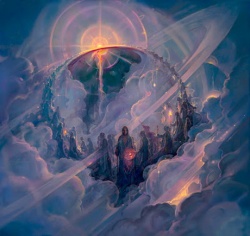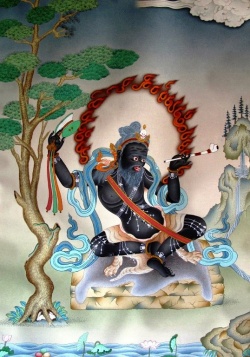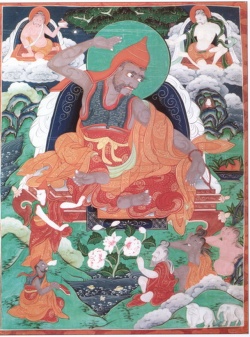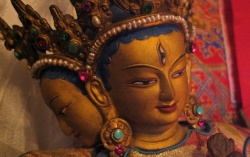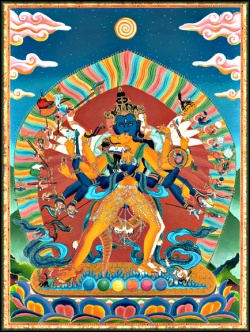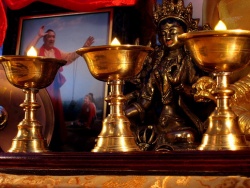The Inner Kālacakratantra - A Buddhist Tantric View of the Individual: The Nature of Syncretism in the Kālacakratantra
The Inner Kālacakratantra
A Buddhist Tantric View of the Individual
A. Wallace
The Nature of Syncretism in the Kālacakratantra
Reading the Kālacakratantra, one immediately notices its prominent, syncretistic character, but close examination of this tantra and its commentarial literature reveals that the Kālacakra tradition has preserved a distinctively Buddhist orientation, and that its affiliation with non-Buddhist Indian systems is in form rather than content. The syncretism of this tantric system is a self-conscious absorption, or appropriation, of the modes of expression that are characteristic of the rival religious systems of India. This self-conscious syncretism variously permeates several areas of the Kālacakratantra, such as its theoretical system, language, medicine, and cosmology; and it is often inextricably related to Buddhist tantric conversionary efforts. For this reason, the term syncretism does not quite fit this tradition, whose rhetorical strategies and linguistic divergences, though cleverly disguised, are firmly rooted in Buddhist doctrine.
The Kālacakra tradition expressly justifies its adaptive character as a skillful means for leading individuals of diverse mental dispositions to spiritual maturation. The Paramādibuddhatantra asserts that “one should teach the Dharma in whatever manner matures sentient beings. ” [1] The conversionary mission of the Kālacakratantra is not the sole basis of its syncretistic character. The growing pluralism within the inner life of Indian Mahāyāna communities could have been another contributing factor in the proliferation of syncretism, for the flourishing of religious pluralism often makes syncretism a necessity rather than just a possibility.
The pluralism that is characteristic of Indian tantric Buddhism can be described as a self-conscious recognition that although the Buddhist tradition is shared by all the members of a specific Buddhist community, the way it is interpreted, analyzed, and experienced differs within that community. It seems that the Kālacakra tradition tried to find grounds for dialogue with other Buddhist and non-Buddhist systems without ignoring their differences; while at the same time, it was apprehensive about losing its own distinct identity. Its ambivalence with regard to its own syncretism is evident throughout the Kālacakratantra and the Vimalaprabhā. For example, while refuting the particular views of the Indian non-Buddhist and the so-called Buddhist heterodox schools, the Kālacakratantra states:
- Kālacakra imparts instruction on the earth for the sake of this and other knowledge of people who have dull, sharp, and other mental dispositions due to the power of their karmic habitual propensities. [2]
At the same time, it warns against the dangers of grasping onto one's own dogmatic position or falling under the influence of other teachings by familiarizing oneself with those teachings in order to refute them:
- Since the mind, like a crystal, is colored by the colors of the objects in its proximity, the yogī should not criticize any teaching that belongs to his own or to another family. [3]
The Vimalaprabhā justifies the Kālacakra tradition's syncretism, asserting that the principle (niyama) of the Bhagavān Kālacakra is that “whatever is identical to the words of the Buddha either in terms of conventional or ultimate truth must not be criticized. ” [4] In accordance with this principle, it cites passages from the writings of heterodox Buddhist schools at times—the Vaibhāṣikas, for example—in order to substantiate its theory; and at other times, it vehemently criticizes other passages from the same writings that express views contrary to those of the Kālacakra tradition.
Likewise, on the one hand, the Kālacakratantra asserts that even when one's own mind is pure, one should not create discord among intelligent and unintelligent people, since they are all Buddhas; [5] and on the other hand, it states that one should not use ferocious mantras to kill living beings but to terrify the host of Māras who are “the authors of the Smṛtis and other murderous heterodox groups (tīthika) who are fond of fighting. ” [6] The Vimalaprabhā interprets here “Māras” as proponents of the Vedic Dharma, and it affirms that a Bodhisattva should use ferocious mantras to generate fear in heterodox groups that their Dharma will be destroyed. [7]
===The Theoretical Syncretism of the Kālacakratantra
As mentioned earlier, the philosophical position advocated in the Kālacakratantra and its related literature is that of the Mādhyamikas, following the line of Nāgārjuna. According to the Kālacakratantra, only Mādhyamikas who assert the nonduality of compassion and emptiness avoid philosophical failure. Thus, adhering to the ontological view of the Mādhyamikas as the only valid one, the Kālacakratantra refutes the tenets of all other Buddhist and non-Buddhist systems. Although the Vimalaprabhā acknowledges diverse Buddhist systems such as Vaibhāṣika, Sautrāntika, Yogācāra, and Madhyamaka as equally authentic teachings of the Buddha, it presents the Madhyamaka system as the pinnacle of the Buddha's teaching, and it claims that the Mādhyamikas are the only ones who are qualified to attain “the non-abiding (apratiṣṭhita) nirvāna that is without remainder (upadhi-rahita), due to the cessation of causes and results, and that is devoid of the waking and deep sleep states and is similar to the dream and the fourth state. ” [8] It affirms the superiority of the Madhayamaka school over other Buddhist schools on the grounds that the Mādhyamika treatises, unlike the scriptures of the aforementioned Buddhist schools, elucidate ultimate reality. [9] The Vimalaprabhā interprets the differences among the four schools of Buddhism
as the Buddha's response to different mental dispositions of sentient beings, some of whom have the fortune of being closer to enlightenment, while some are further from enlightenment. It also views the differing teachings of the four Buddhist schools as the Buddha's response to the teachings of four different non-Buddhist groups, that is, as his conversionary means. It asserts: Since beginningless time, all sentient beings have been heterodox (tīrthika), devoted to the Dharmas of gods, spirits (bhūta), and asuras, deprived of the path of omniscience, placing themselves into one of the four castes, desiring the pleasures that are the reward of heaven, and asserting [the existence of] a creator and the Self (ātman).
Among them, those who rely on the Dharmas of gods and pretas are proponents of “correct words” (śabda-vādin), Īśvara, the Self, and social discrimination (jāti-vādin). Those who rely on the Dharmas of the Barbarians (mleccha) and asuras are proponents of a creator and a soul (jīva) and are devoid of the propagation of social discrimination. [10] Thus, according to the Kālacakra tradition, all followers of the four schools of Buddhism at some time or another belonged to the heterodox groups, and as they further pursued the issues related to the religious teachings they followed and finally settled with Buddhist answers to those issues, they converted to Buddhism.
Thus, the Vaibhāsikas are said to be Buddhist converts who previosly followed the Barbarian Dharma. The Sautrāntikas are Buddhist converts who previously propagated the theories of a creator, correct words, Īśvara, and class discrimination; and the Yogācārins are Buddhist converts who previously held the view of the permanent Self and the creator; whereas, the Mādhyamikas are the converts who abandoned not only the aforementioned heterodox views but also the dogmatic positions and related meditative practices that are characteristic of the other three Buddhist schools. The Vimalaprabhā describes the manner of their conversion to Buddhism in the following way: Among those Barbarians (mleccha) there are two types of grasping—grasping onto the agglomeration of atoms and grasping onto the [truly existent) person (pudgala) who has origination. Their belief is: “If a person who has the origination and dwells in the body that consists of the agglomeration of atoms does not exist, then who will take on another body after the body that consists of the agglomeration of atoms has perished? Therefore, a spontaneously arisen person (upapāduka-pudgala) does exist.
By meditating on this, the reward of heaven, or the reward of nirvāna, comes about. Apart from the reward of heaven, there is no other nirvāna. ” At the time when they sought the truth, knowing the thoughts of their minds, the Bhagavān who knows reality said: “There is a person who carries the burden, but I do not say that he (exists) permanently or impermanently. ” This is true, since according to the Bhagavān's words, it is not possible to say that a person who is [a manifestation of] mental habitual propensities in the dreaming state is permanent or impermanent. Abandoning the Dharma of Barbarians due to this statement of the Tathāgata, they have become the Buddhist Vaibhāsikas. Moreover, some, hearing the highest Dharma as it was being taught to the Bodhisattvas and abandoning the grasping onto the [truly existent) person, resorted to the path of the Samyaksaṃbuddha. Furthermore, among the Sautrāntikas, there is grasping onto the agglomeration of atoms. The belief of these substantialists (artha-vādin) is: “If the animate and inanimate things that inhabit space do not exist, then the triple world would not exist
either. In the absence of samsāra, there would be nonfavorable or unfavorable states of existence. Likewise, neither Buddhas nor Bodhisattvas would exist, nor would the supreme nirvāna exist. One could not see the Bhagavān's relics because of the absence of the substance present in the matter. ” At the time when they sought the truth in this way, the Bhagavān, knowing the thoughts of their minds, said: “There is the final body [of the Bhagavān) that consists of the agglomeration of atoms and is endowed with thirty-two characteristics of the Great Man, by means of which the state of the Samyaksaṃbuddha and the sublime parinirvāna come into existence.
” This is true because of the appearance of the Bhagavān's relics. Thus having heard of the power of the body that consists of the agglomeration of atoms and abandoning the propagation of social discrimination, correct words, Īśvara, and a creator, they became the Buddhist Sautrāntikas. Moreover, some, hearing the instruction on the supramundane Dharma to Bodhisattvas and abandoning the grasping onto that substance (artha), resorted to the path of the Samyaksaṃbuddha. Among the Yogācārins, there is grasping onto consciousness. The belief of these proponents of consciousness is: “The entire three worlds are consciousness only. The so-called atom does not exist because it is a division that consists of the six constitutent parts. Just as in the dreaming state the things that are mere appearances of the mind engage in activities even though there is an absence of atomic matter, so too in the waking state a thing appears by means of an unreal thing, like a hair-net or a golden conch appearing to the eye soiled with dark dirt. ”
At the time when they sought the truth in this way, the Bhagavān, knowing the thoughts of their minds, said: “The triple world is consciousness only. Apart from consciousness, there is no other samsāra. The cessation of the seed of cyclic existence is due to the cessation of mundane consciousness (laukika-vijñāna). Due to that, there is nirvāna. ” This is true. The manifestation of suffering and happiness arises from the animate and not from the inanimate. So-called suffering and happiness are samsāra, and their absence is nirvāna. Thus, hearing the Bhagavān's words and abandoning the theory of the creator and the Self, they became the Buddhist Yogācārins. Moreover, some, hearing the instruction on the supramundane Dharma to Bodhisattvas and abandoning the propagation of consciousness, resorted to the path of the Samyaksaṃbuddha. [11]
It further argues that just as the Buddha taught different theories to the four types of Buddhists, so he taught them different meditative practices that were in accordance with their differing views. For example, he taught meditation on the impermanence of a person to the Pudgalavādins, meditation on the kṛtsnās to the Arthavādins, meditation on cognition only (vijñapti-mātra) to the Vijñānavādins, and to the Mādhyamikas, he taught meditation on the dreamlike and imperishable gnosis. [12] Thus, in light of its view of the superiority of the advanced Mādhyamika teachings and practices, the Kālacakra tradition associates the Mādhyamikas with spiritually mature Buddhists who, abandoning all dogmatic positions and related meditative practices of the other three Buddhist schools, succeed in reaching the highest spiritual goal. Nevertheless, the Kālacakra tradition argues that there is no distinction between the Mādhyamikas and the heterodox groups with regard to the manner in which conventional reality appears. It regards the investigation of conventionally existent phenomena and the notions of the conventional creator, means of action, and action as common to all, Buddhists and non-Buddhists alike. It affirms that the only major difference between its philosophical views and those of the heterodox groups
is in its understanding of the nature of emptiness, which is identitylessness of two kinds—personal identitylessness (pudgala-nairātmya) and phenomenal identitylessness (dharma-nairātmya). [13] That view of the commonality of the Mādhyamika's and the heterodox groups' speculative approaches to conventional reality facilitated the Kālacakratantra's import of certain ideas and theoretical models from other philosophical systems and induced its theoretical syncretism. By incorporating the ideas characteristic of other philosophical systems into its own theoretical framework and by attributing conventional validity to them, the Kālacakratantra attempts to accomplish two objectives: namely, to provide rational explanations pertaining to human psycho-physiology, and to convert heterodox groups.
Textual study of this tantric tradition reveals the following two goals of the Kālacakra tradition's theoretical syncretism: the conversion of heterodox groups, and the modeling of conventional reality for meditational purposes. For example, the Sā khya's qualitative ṃ dualism of consciousness (puruṣa) and matter (prakṛti) is adopted by the Kālacakratantra as a heuristic device for explaining the nature of the human being from the conventional point of view. However, the Sāṃkhya's concepts of puruṣa and prakṛti, which permeate the theoretical framework of this tantra, are not taken literally from the Sāṃkhya philosophical system. Rather, they are reinterpreted and adapted to the Kālacakratantra's own unique system. Thus, in the context of the Kālacakratantra, the twenty-five principles of prakṛti are the five aggregates (skandha), the five elements (dhātu), the twelve sense-bases (āyatana), intellect (buddhi), self-grasping (ahaṃkāra), and the mind (manas).
The prakṛti of the human being is devoid of inherent nature (svabhāva), and from the ultimate point of view, it is luminous. In contrast, in the Sāṃkhya philosophical system, the twenty-four principles of prakṛti forming the human being include the primordial prakṛti (mūla-prakṛti), which is an independently existent and inherently generative phenomenon, and its twenty-three temporal subdivisions. Likewise, in the Kālacakratantra, the aggregates, elements, and sense-bases form the prakṛti of the transmigratory body, [14] and the five elements, intellect, self-grasping, and the mind form the prakṛti of the transmigratory mind. [15] In Sāṃkhya, on the other hand, only the intellect, self-grasping, and the mind form the “inner organ” (antaḥh-karaṇa); and when combined with the sense-faculties (buddhīndriya), faculties of action (karmendriya), and subtle elements (tanmātra), they form the subtle body (liṇga-śarīra), which is separable from the gross body and thus capable of transmigrating through a series of gross bodies which are aggregations of the five gross elements.
There is also a difference in terms of the origination of the gross and subtle elements. According to Sāṃkhya, the five gross elements are derivatives of the subtle elements beginning with sound, and so forth; [16] whereas in the Kālacakratantra, the five gross elements are said to give rise to sound and other subtle elements. [17]It is not quite clear what is meant in the Kālacakratantra by the terms buddhi, manas, and ahaṃkāra. The Indian commentarial literature does not elucidate these points, and Tibetan commentaries understand them in different ways. For mKhas grub rje, the eight constituents of the prakṛti of the transmigratory mind are eight of the twenty-five principles of prakṛti and puruṣa, as categorized by the Sāṃkhya philosophical system. mKhas grub rje does not mention whether or not we should understand buddhi, manas, and ahaṃkāra in the way in which Sāṃkhya interprets them. He thus leaves us with a puzzle and room for speculation. Bu ston's annotations [438], on the other hand, suggest that buddhi here refers to the five sensory faculties (buddhīndriya), that manas designates conceptualization (vikalpa), and that ahaṃkāra refers to the defiled, or afflicted mind (kliṣṭa-manas), referring to a subtle feeling of “I. ”
This concept of an afflicted mind is characteristic of the Yogācāra's classification of the mind and not of the Mādhyamika. Bu ston's interpretation of the term buddhi definitely differs from that in Sāṃkhya, which considers buddhi a part of the “inner organ” that makes decisions, cognitively and ethically. [18]However, Bu ston's explanations of the terms manas and ahaṃkāra correspond in some ways to the implications of those terms in Sāṃkhya, which regards conceptualization as one of the functions of the manas, [19] and interprets ahaṃkāra as a part of the “inner organ” that appropriates all experiences to itself. The fact that the Kālacakratantra uses these philosophical terms without clearly explaining their meaning is one more indication of the author's conscious attempt to incorporate the Sāṃkhya system into its universal model of conventional reality. [20] Likewise, despite some striking similarities between the Sāṃkhya's and the Kālacakratantra's interpretations of puruṣa, there are some basic differences with regard to the nature of the puruṣa and its relation to prakṛti.
In both systems, the puruṣa refers to consciousness which pervades prakṛti but itself is neither prakṛti nor its derivative, and which is free of the three properties—namely, sattva, rajas, and tamas—and is neither bound nor liberated by anything. However, whereas in the Sāṃkhya philosophical system, the puruṣa is an independently existent reality, a contentless presence, or an inactive witness devoid of bliss, in the Kālacakratantra, the puruṣa is of the nature of innate gnosis (sahaja-jñāna), which is blissful omniscience; and it transcends both samsāra and nirvāna, and yet is active in supporting both. For the schematization of the above mentioned differences between the Sāṃkhya's and Kālacakratantra's interpretations of puruṣa and prakṛti, see table 3.1. Similarly, the Kālacakratantra way of understanding the guṇas of prakṛti does not correspond in every way to the Sāṃkhya's interpretation. In some instances, instead of sattva, rajas, and tamas, the Kālacakratantra specifies the five sense-objects—smell, sound, form, taste, and touch—as the guṇas of prakṛti. [21] Being subject to origination and cessation, they are said to have the characteristics of conceptualizations and bind the individual to the cycle of existence. In other instances, the three guṇas —sattva, rajas, and tamas—correspond to the moral distinctions among sentient beings' mental dispositions that are induced by their own karma. [22]
In yet other instances, the Kālacakra tradition refers to the three guṇas in ways that are open to multiple interpretations. For example, when it speaks of the gross, subtle, and supreme natures (prakṛti) of the mind as being contained in the three guṇas, it does not fully explain the manner in which it understands the three guṇas in this particular context. The Vimalaprabhā suggests only that in the Kālacakratantra's classification of the nature of awareness as gross, subtle, and supreme, the gross nature of the transmigratory mind, which apprehends phenomena with the gross sense-faculties, is characterized by the waking state. This state is said to correspond to sattva, that is to say, to the daytime. The subtle nature of the mind, which apprehends mental phenomena that are like an illusion, is characterized by the dreaming state, which is said to correspond to rajas, or to twilight.
The supreme nature of the mind, which discards all phenomena, is characterized by the state of deep sleep, which is thought to correspond to tamas, or to midnight. If not examined within its own context and in light of the Madhyamaka view of sattva, rajas, and tamas, this threefold classification of the nature (prakṛti) of the mind, related to sattva, rajas, and tamas, may appear identical to that of non-Buddhist tantric systems, particularly of the nondual Kaśmīr Śaivism. [23] It is quite plausible that the Kālacakratantra introduced that type of categorization of the nature of awareness from Kaśmīr Śaivism as a useful model to describe the conventional aspects of the transmigratory mind.
In light of the fact that the Kālacakra tradition explicitly reaches out to a nonBuddhist audience, sattva, rajas, and tamas may be interpreted in accordance with the Sāṃkhya philosophy. On the other hand, there are some internal indications that for Buddhists not committed to that interpretation, the names of these three guṇas can simply be taken as ciphers to relate the three humors in the body—phlegm (kapha), bile (pitta), and wind (vāyu)—to the three nāḍīs in the body—idā on the left, pingalā on the right, and suṣumnā in the center—and to specific physiological or mental processes of three kinds, and so on. [24] Likewise, it is plausible that the Kālacakratantra's description of the fourth nature of the mind comes originally from the Śaiva tantras, for the classification of the four types of awareness was known in non-Buddhist Indian traditions since the time of the Upaniṣads.
Within the context of the Kālacakratantra, the fourth state of the mind is a state that supports the three aforementioned states. It is characterized by the emission of regenerative fluids. Comparative analysis of the expositions of the fourth state of the mind in the Kālacakratantra and in Śaiva tantras reveals striking similarities, and yet it shows some fundamental differences with regard to the nature of that state. They agree that the fourth state of the mind marks the blissful state of consciousness in which all conceptualizations disappear and any sense of duality vanishes. However, in Śaiva tantras, [25] the fourth state of the mind is also a state of selfrealization, a state in which one becomes aware of one's undivided, essential Self, and consequently becomes free of spiritual ignorance (avidyā). It is a condition by which one rises to the fifth state, or the state of liberation, within one's lifetime (jīvanmukti). In the Kālacakratantra, on the other hand, the fourth type of awareness, though nondual at the time of the emission of regenerative fluids, is still tainted with the habitual propensities of spiritual ignorance (avidyā-vāsanā) and is thus embedded in the cycle of existence.
The aforementioned examples demonstrate some of the ways in which the Kālacakratantra endeavors to simultaneously achieve both its goals—to offer rational explanations concerning the individual, and to convert Śaivites and other heterodox groups adhering to the Sāṃkhya's world view—without compromising its fundamental tenets. Similarly, in order to attract the Vaiṣṇavas and to illustrate its view of the physical and mental development of the human being, the Kālacakratantra uses the model of the ten avatāras of Viṣṇu as an analogy for the ten phases of human life. By so doing, it introduces its own unique interpretation of Viṣṇu's avatāras. Thus, in the Kālacakratantra, [26] Viṣṇu is also referred to as Viṣṇu Vajradhara, the individual's mindvajra. He is identified here with the gandharva being, or the being of the intermediate state (antar-bhāva), being conveived in the womb and undergoing different stages in the different phases of life inside and outside the womb.
For example, as a fetus, one assumes the forms of a fish, tortoise, and boar; at birth, one becomes a man-lion; in early childhood, one is in the dwarf-stage; at the time when the first teeth grow until they fall out, one is in the stage of Rāma; in adolescence, one experiences the stage of Paraśurāma; from adolescence until the appearance of gray hair, one experiences the stage of Kṛṣṇa; in old age, one is in the stage of a Buddha, and on the day of death, one attains the stage of Kalkī. Interpreting Viṣṇu's avatāras in this manner, the Vimalaprabhā cautions against adopting the standard interpretation of the
Purānic teachings on the grounds that they are meaningless, lead to hell, and are devised by corrupt Brāhmanas in order to deceive simple-minded people. [27] This is one of many instances in which the Kālacakratantra tradition contemptuously disparages the Vaiṣṇava tradition and its teachings. It frequently refers to the Brāhmaṇic teachings, especially those of the Purānas, as false teachings, devoid of reasoning, creating confusion among foolish people, and composed by corrupt Brāhmaṇic sages for the sake of promoting their own social class. [28] One reason for such assertions was the overt animosity between the Buddhists and the adherents of the Brāhmaṇic tradition in the northern India of the late tenth and eleventh centuries. This was an era in which the influence of the Purānas and strength of Brāhmaṇism steadily increased, and in which orthodox Brāhmaṇic schools jointly stood in opposition to Buddhist ideology, posing a threat to the entire Buddhist tradition. One of many examples of internal evidence of the antagonism between the Brāhmaṇic and Buddhist traditions of that time is their contention over the issue of which Dharma is the best one.
The Vimalaprabhā refutes the Brāhmaṇic claim that the Vedic Dharma is superior to the Buddha Dharma because it is earlier and innate (sahaja), whereas the Buddhist Dharma is later and fabricated (kṛtaka). It argues that just as the earlier and innate ignorance is not better than later knowledge, so too the fact that the Vedic Dharma is earlier and innate does not mean that it is best. Even though it is earlier and innate, it does not illuminate the path to omniscience, for it is characterized by the darkness of ignorance. Therefore, the Vimalaprabhā states, the later Buddha Dharma was created in order to destroy the great darkness of the Vedic Dharma. Speaking from the Buddhist tantric point of view, the Vimalaprabhā argues that the Buddhist Dharma is superior to the Vedic Dharma because nirvāṇa comes about only by means of a sādhana on the supreme, imperishable gnosis (paramāksarajñāna) and not by means of the Vedic Dharma, which consists of nothing but the habitual propensity of seminal emission. [29]
In addition to the aforementioned instances in which the Kālacakratantra adopts and redefines concepts characteristic of non-Buddhist systems, it also incorporates non-Buddhist cosmological views without reinterpreting them. For example, in its classification of the infernal realms and its description of the size of Meru, the Kālacakra tradition closely parallels the Jaina cosmological view; and its description of the four cosmic maṇḍalas also parallels those in the Purāṇas. [30] The fact that the conversion of heterodox groups was one of the motivations behind the Kālacakratantra's adoption of specific non-Buddhist ideas implies that its teachings pertaining to the Kālacakra worldview were not kept secret from the public; that is, they were not guarded as secret teachings intended for an initiated elite.
Moreover, the Kālacakra tradition's preference for explicitly presenting its specific tantric views is a result of its openly professed conversionary endeavors. The Syncretism of Kālacakratantra Practice There is clear evidence in the Kālacakra literature that even the teachings and practices pertaining to the Kālacakra initiation were accessible to heterodox groups, whether they were seeking only mundane siddhis or the realization of the supramundane gnosis. With regard to its initiation, the Kālacakratantra [31] asserts that whether one is a Buddhist, a Śaiva, a Brāhmaṇa, a naked mendicant (nagna), a snātaka (a Brāhmaṇa beggar), a kāpālī (a follower of a Śaiva sect, who wears a garland of human skulls and eats and drinks from them), a Jaina mendicant (lupta-keśa), a hermit (maunī), or a follower of the left-hand Śāktism (kaulī), one will obtain purity and all virtues by receiving the Kālacakra initiation. It substantiates that assertion on the grounds that through initiation into the Kālacakra-maṇḍala one becomes initiated into all maṇḍalas, including those of the deities belonging to those heterodox groups. [32] In its attempt to attract heterodox groups, the Kālacakratantra includes in its maṇḍala the deities that were equally accepted by Hindus, Jainas, and Buddhists as objects of worship and meditation. In this way it introduced its practical syncretism into the practice of the stage of generation.
However, just as the Kālacakratantra's theoretical syncretism often lends itself to both Buddhist and non-Buddhist interpretations, so too can these deities of the heterodox groups be viewed either as nonBuddhist deities or—as the Vimalaprabhā [33] suggests—as symbolic representations of the diverse factors of Buddhahood. [34] The Kālacakra tradition is the only Buddhist tantric tradition that fully discloses the symbolic representations of its adopted nonBuddhist deities. While the Kālacakratantra incorporates into its maṇḍala the diverse deities that were worshipped by both Buddhists and non-Buddhists, the Vimalaprabhā admonishes the Buddhist tantric yogīs who seek liberation and wish to advance in Kālacakratantra practice by meditating on the supramundane siddhis not to perform sādhanas on the deities and mantras of the outsiders. Its rationale for this is that the deities of the outsiders cause minor misfortunes, and even when they are meditated upon, they look for the faults of the meditator and become his enemies.
It points to the futility of meditation on non- Buddhist deities in this manner: Meditated upon, what will they, who are like poor men, give? When meditated upon, they say: “Hey sādhaka, we will obey your every command. ” If the sādhaka says, “Tie the king and bring him here, ” then they refuse, [saying]: “We are incompetent in this matter. ” Likewise, the insignificant deities who are meditated upon refuse [to help] with regard to omniscience. [35] Moreover, textual study of the Kālacakratantra shows that receiving the Kālacakratantra initiation did not entail taking refuge in the Buddha, Dharma, and Saṅgha. It is clear that non-Buddhist recipients of the Kālacakra initiation did not have to become Buddhists. However, the fact that the subsequent tantric practice of the stage of generation begins with taking refuge [36] implies that those wishing to engage in more advanced Kālacakra practices had to commit themselves to the Buddhist path. Study of the fourth chapter of the Kālacakratantra, which describes the practice of the stages of generation, suggests that that mode of practice was introduced partly with the intention of accommodating new converts to this tantric path.
Moreover, the Vimalaprabhā [37] asserts that the Kālacakra sādhana is to be taught first as a dualistic practice, based on the differentiation between the visualized deity as permanent (nitya) and the meditator as impermanent (anitya), for the sake of the mental purification and conversion of the foolish who have not yet realized that their visualized object is ultimately their own mind. The term “foolish” (bāla) is recurrently used in the Kālacakra literature to describe the members of heterodox groups.
The examples given above demonstrate two important facts. The first is that the Kālacakra tradition's reconciliation of non-Buddhist views with its own is primarily achieved through its reinterpretation of non-Buddhist ideas; and the second fact is that its conversionary effort was the most important factor in inducing its theoretical and practical syncretism.
The Syncretism of the Kālacakratantra's Language
The Kālacakratantra's aforementioned expressions of syncretism are also reflected in its language. They induce the specific types of lexical and semantical syncretism found in this tantra, which is characterized by a diverse mixture of Buddhist and nonBuddhist terms. As we saw earlier, at times the terms borrowed from non-Buddhist systems convey the ideas characteristic of those systems; at other times, they convey traditional Buddhist ideas; and at yet other times, they designate new Buddhist ideas specific to this tantric system. The Vimalaprabhā interprets the Kālacakratantra's linguistic divergences as its way of transcending the class discrimination of the rivaling Hindu groups, which prohibit the Vaiṣyas, Śūdras, and other low classes from studying their scriptures, saying, “Here in the land of mortals, the Vaiṣyas, Śūdras, and others born in degraded wombs, must not study the Vedas and must not take up the mendicant's life and staff. ” [38]
It also views the Kālacakratantra's linguistic syncretism as a way of overcoming the alienation created by conservative Buddhist ways of institutionalizing the language of the north Indian Buddhist tradition, upheld by Buddhists who, “seeing the arrogance of the heterodox paṇḍitas who propound the proper words, think: 'Just as the chosen deities of the Brāḥmaṇas, Vaiṣṇavas, Śaivas, and others—Brahmā, Hari, Hara, and others—speak Sanskrit, so too our chosen deities, the Buddhas and Bodhisattvas, speak Sanskrit. ” ' [39] Another facet of the Kālacakratantra's lexical syncretism manifests in the usage and reinterpretation of Buddhist terms of different Buddhist schools.
For example, the Kālacakratantra frequently employs the Yogācāra's term ālaya-vijñāna (repository consciousness) simply to designate vijñāna (consciousness). Taking into account the interpretation of the Vimalaprabhā commentary, which glosses ālaya-vijñāna as vijñāna and jīva, the Kālacakratantra's general view of the nature of the mind, and its refutation of the Yogācāra's classification of the mind, one may infer that the term ālayavijñāna in this tantric tradition designates not the Yogācāra's concept of an ethically neutral repository of the habitual propensities of karma, but a continuum of mental consciousness. This particular type of lexical syncretism results from the Kālacakratantra's effort to convert the adherents of Buddhist schools other than Madhyamaka. The Vimalaprabhā explicitly refers to Yogācārins, Sautrāntikas, and Vaibhāsikas as simple-minded Buddhist heretics (bauddha-tīrthika). [40] The Kālacakra tradition's conversionary endeavors may also be traced to yet another facet of its lexical syncretism, namely, the usage of terms originating from Indian vernaculars. For example, the terms chandoha, upachandoha, melāpaka, upamelāpaka, and others, which designate the names of the specific bodily joints, do not have clear Sankrit etymologies. Since the author of the tantra demonstrates his familiarity with the Āyurvedic medical treatises such as the Caraka and Suśruta
Samhitās, which employ standard Sanskrit terms to designate those bodily parts, it is certain that the usage of these terms was not accidental.
In light of the preceding discussions, one may draw several conclusions. First, the above-mentioned characteristics of the Kālacakratantra's pervasive syncretism demonstrate the diversity of that syncretism. Second, it is the prevailing reinterpretative aspect of the Kālacakratantra's syncretism that ensures this tantra's coherence and gives it a distinctively Buddhist character. Third, the different features of the Kālacakratantra's syncretism are incidental to the various immediate goals that this tantra attempts to accomplish by resorting to syncretism. As mentioned earlier, there are several reasons for the Kālacakratantra's syncretism. The first is to enhance and enrich its presentation of conventional reality. The second is its expressed aim of proselytism. In support of this claim, it is well to remember that during the late tenth and early eleventh centuries, northern India was subjected to frequent raids by the Muslim chief Amīr of Ghaznī and his son Sultan Mahmūd, whose forces took tens of thousands of slaves and plundered the country's treasures.
In the midst of this brutal invasion, the author of the Kālacakratantra may well have sought to form a united front of heterodox groups and Buddhists, a new ecumenical movement that would stand up against this common foe, who exemplified the “Barbarians” (mleccha). Likewise, dangerous times like these often create a world of religious uncertainty that can sometimes be warded off by precarious theoretical and practical forms of religious affirmations, which may be seen as heretical. The fact that a conversionary mission is the most compelling factor in inducing the Kālacakratantra's syncretism brings us to a simple but pertinent question: Why does the Kālacakratantra resort to syncretism in order to fulfill its conversionary goals? The answer may be threefold. First, by incorporating heterodox theories and practices, it makes its own system more accessible to those whom it is trying to attract. That is, by presenting its own views in terms that the heterodox groups are steeped in and with which they are comfortable, it makes its own theory more readily understandable to them.
Second, it acknowledges aspirations already cherished by its potential Buddhist and non-Buddhist followers—such as physical health, mundane siddhis, immortality, and liberation—and shows them how to accomplish these aims by means of Kālacakratantra practice. Third, by means of syncretism, it tries to demonstrate that in terms of conventional reality there is no fundamental difference between the views of the heterodox systems and the Kālacakratantra, and that no theory describes any purported inherent nature of the world. However, this assertion of the essential compatibility between the heterodox and Kālacakratantra views appears to be contradictory, for the Kālacakra tradition undeniably refutes and reinterprets others' views concerning the conventional nature of phenomena. This dilemma may be a philosophical one which the Kālacakra tradition, due to its adoptive strategies, cannot avoid; but there may perhaps be a deeper justification that can be discovered through further research into this subject.
Footnotes
- ↑ The Paramādibuddhatantra, cited in the Vimalaprabhā, 1986, Ch. 1, p. 24.
- ↑ The Kālacakratantra, Ch. 2, v. 177, lines a—b.
- ↑ Ibid., lines c—d. This analogy of the mind's impressionability to that of a crystal is most likely borrowed from the Yoginīsaṃcāratantra, Ch. 11, v. 2, which is cited in a different context in the Vimalaprabhā commentary on the Kālacakratantra, Ch. 5, v. 47: :yena yena hi bhāvena manaḥ saṃyujyate nṛṇām tena tanmanyatāṃ yāti viśvarūpo maṇir yathā.
- ↑ The Vimalaprabhā commentary on the Kālacakratantra, Ch. 2, v. 176.
- ↑ The Kālacakratantra, Ch. 5, v. 66.
- ↑ The Kālacakratantra, Ch. 5, v. 86.
- ↑ The Vimalaprabhā commentary on the Kālacakratantra, Ch. 5, v. 86.
- ↑ The Vimalaprabhā commentary on the Kālacakratantra, Ch. 5, v. 127.
- ↑ Ibid.
- ↑ Ibid.
- ↑ Ibid.
- ↑ Ibid.
- ↑ The Kālacakratantra, Ch. 2, v. 161, and the Vimalaprabhā
- ↑ The Kālacakratantra, Ch. 2, v. 85, and the Vimalaprabhā.
- ↑ The Kālacakratantra, Ch. 2, v. 86, and the Vimalaprabhā.
- ↑ The Sāmkhyakārikā, vs. 22, 28.
- ↑ The Kālacakratantra, Ch. 2, v. 83, and the Vimalaprabhā.
- ↑ See Sāṃkhyakārikā, v. 23.
- ↑ According to Sāṃkhya, the functions of the mind (manas) are: analyses and conceptualization (vikalpa), and decision and determination (samkalpa).
- ↑ One can encounter a similar procedure in the Bhagavad Gīta's exposition of the universal validity of the Krsna doctrine, where it often uses its terms with overlapping meanings. Cf. Edgerton's essay (Ch. 10), accompanying his translation to The Bhagavad Gīta, 1972, p. 179.
- ↑ The Kālacakratantra, Ch. 2, vs. 83, 85.
- ↑ The Kālacakratantra, Ch. 2, v. 93.
- ↑ See M. Dyczkowski, tr., The Aphorisms of Śiva: The Śiva Sūtra with Bhāskara's Commentary, the Vārttika, 1992, Ch. 1, v. 11.
- ↑ The Vimalaprabhā commentary on the Kālacakratantra, Ch. 2, vs. 61, 65, 86.
- ↑ See Dyczkowski, tr., The Aphorisms of Śiva, pp. 43, 138, 140; J. Singh, tr., The Yoga of Delight, Wonder, and Astonishment: A Translation of the Vijñāna-Bhairava, 1991, pp. 71, 79–80.
- ↑ The Kālacakratantra, Ch. 2, v. 7, and the Vimalaprabhā.
- ↑ See the Vimalaprabhā commentary on the Kālacakratantra, Ch. 2, v. 8.
- ↑ See the Vimalaprabhā commentary on the Kālacakratantra, Ch. 5, v. 127.
- ↑ Ibid.
- ↑ For further information on the Kālacakratantra cosmology, see chapter 5 on the “Cosmic Body. ”
- ↑ The Kālacakratantra, Ch. 3, v. 169.
- ↑ See the Vimalaprabhā commentary on the Kālacakratantra, Ch. 3, v. 169.
- ↑ See the Vimalaprabhā commentary on the Kālacakratantra, Ch. 3, vs. 167–168.
- ↑ Ibid.
- ↑ The Vimalaprabhā commentary on the Kālacakratantra, Ch. 5, v. 127.
- ↑ See the Kālacakratantra, Ch. 4, v. 5.
- ↑ The Vimalaprabhā commentary on the Kālacakratantra, Ch. 4, v. 48.
- ↑ The Vimalaprabhā commentary on the Kālacakratantra, 1986, Ch. 1, p. 40.
- ↑ Ibid., p. 34.
- ↑ See the Vimalaprabhā commentary on the Kālacakratantra, Ch. 2, v. 173.
Continue reading
- The Inner Kālacakratantra - A Buddhist Tantric View of the Individual: Preface
- The Inner Kālacakratantra - A Buddhist Tantric View of the Individual: Introduction
- The Inner Kālacakratantra - A Buddhist Tantric View of the Individual: The Broader Theoretical Framework of the Kālacakratantra
- The Inner Kālacakratantra - A Buddhist Tantric View of the Individual: A History of the Ṣaḍ-aṅga-yoga of the Kālacakratantra and Its Relation to Other Religious Traditions of India
- The Inner Kālacakratantra - A Buddhist Tantric View of the Individual: The Nature of Syncretism in the Kālacakratantra
- The Inner Kālacakratantra - A Buddhist Tantric View of the Individual: The Concept of Science in the Kālacakra Tradition
- The Inner Kālacakratantra - A Buddhist Tantric View of the Individual: The Cosmic Body
- The Inner Kālacakratantra - A Buddhist Tantric View of the Individual: The Social Body
- The Inner Kālacakratantra - A Buddhist Tantric View of the Individual: The Gnostic Body
- The Inner Kālacakratantra - A Buddhist Tantric View of the Individual: The Transformative Body
